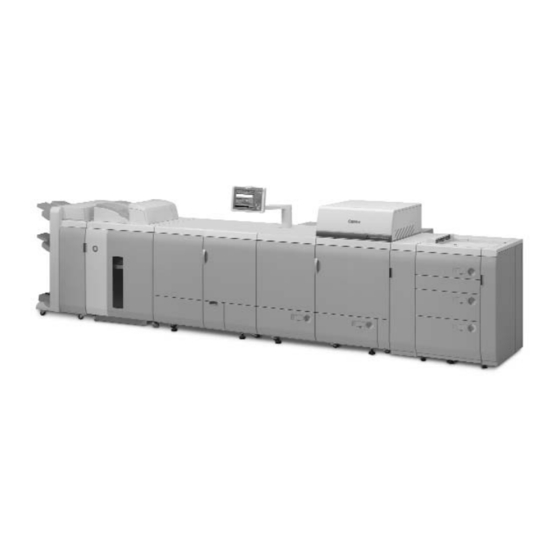
Summarization of Contents
Chapter 1 Specifications
1.1 Product Specifications (finisher)
Details the technical specifications for the finisher, including paper size, number of trays, and stapling methods.
1.2 Names of Parts
Identifies key components with external views and cross-section diagrams, including trays, covers, and units.
Chapter 2 Installation
2.1 Making Pre-Checks
Guides users through checking the contents of the package before starting the installation process.
2.2 Installation Procedure
Provides step-by-step instructions for connecting the finisher to the host machine and high-capacity stacker.
2.3 Making Adjustments
Details how to adjust the finisher's height for proper installation and operation, ensuring no paper jams.
2.4 Attaching the Labels etc.
Instructs on affixing various labels, such as guide maps and staple labels, to the finisher.
Chapter 3 Functions
3.1 Basic Construction
Provides an overview of the machine's five main blocks: electrical control, stacking, transport, intermediary tray, and saddle stitcher.
3.2 Electrical Control Unit
Explains the electrical control block, including the finisher and saddle stitcher controller PCBs and their functions.
3.3 Stacking Unit
Describes the up/down movement of delivery trays and paper surface detection mechanisms.
3.4 Feeding Unit
Details the paper transport block, paper path switching, and jam detection sensors.
3.5 Intermediate Process Tray Assembly
Explains how the intermediary tray shifts, staples, and delivers sheets.
3.6 Saddle Stitcher Unit
Covers the operations of the saddle stitcher block, including transport, alignment, stitching, and folding/delivery.
3.7 Detecting Jams
Lists the sensors used for paper presence detection and jam detection within the finisher assembly.
3.8 Power Supply
Details the DC power supplies, protective mechanisms, and circuit diagrams for the machine.
Chapter 4 Parts Replacement Procedure
4.1 Removing from the Host Machine
Provides steps for disconnecting the finisher unit from the host machine, including cable detachment.
4.2 External Covers
Details the procedures for removing various external covers of the finisher unit.
4.3 Drive System
Explains the removal and replacement of drive system components like motors, belts, and staple units.
4.4 Document Feeding System
Covers procedures for removing and replacing parts related to paper feeding, stacking, and delivery.
4.5 Electrical System
Details the removal procedures for electrical components such as PCBs, sensors, and static eliminators.
Chapter 5 Maintenance
5.1 User Maintenance
Lists items that users can maintain, such as replacing the staple cartridge and disposing of waste staples.
5.2 Maintenance and Inspection
Covers periodically replaced parts, durables, and scheduled servicing for the finisher and saddle stitcher.
5.3 Adjustment
Provides detailed procedures for various adjustments, including height, registration, sensor intensity, and stapling positions.
5.4 Troubleshooting
Offers guidance on identifying and resolving malfunctions and EEPROM problems.
5.5 Outline of Electrical Components
Lists and illustrates sensors, microswitches, solenoids, motors, fans, and PCBs for the finisher unit.
5.6 Variable Resistors (VR), Light-Emitting Diodes (LED), and Check Pins by PCB
Details LEDs and check pins on the finisher controller PCB used for servicing.
5.7 Upgrading
Information on performing software upgrades by connecting to a copy machine.
5.8 Service Tools
Recommends solvents and oils for cleaning and lubrication during maintenance.
Chapter 6 Error Code
6.1 Jam Codes
A table listing jam types, associated sensors, their conditions, and corresponding codes.
6.2 Error Codes
A table detailing error codes, their classifications, descriptions, and recommended treatments.







Need help?
Do you have a question about the Saddle Finisher-AB2 and is the answer not in the manual?
Questions and answers